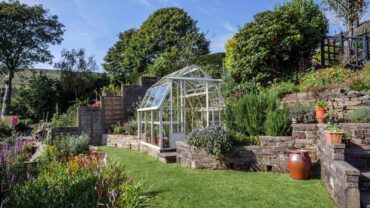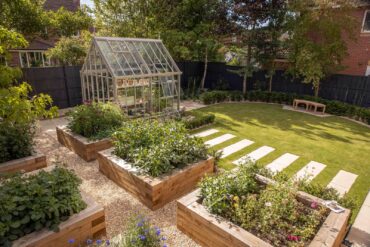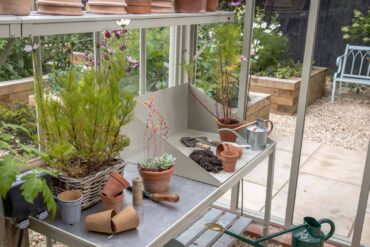 During the pandemic lockdown, many homeowners had a renewed interest in greenhouses. If you’ve been inspired to think about owning a glasshouse or greenhouse for the first time, but you don’t know where to start, Hartley Botanic — a manufacturer of handmade English glasshouses and greenhouses — has provided the answers to some of the most common questions asked by its new customers.
During the pandemic lockdown, many homeowners had a renewed interest in greenhouses. If you’ve been inspired to think about owning a glasshouse or greenhouse for the first time, but you don’t know where to start, Hartley Botanic — a manufacturer of handmade English glasshouses and greenhouses — has provided the answers to some of the most common questions asked by its new customers.
What size and type of glasshouse or greenhouse should I buy?
Knowing how you would like to use and enjoy your greenhouse will help decide on a design and final size. A greenhouse can bring your garden alive in many ways, as well as expand how you use your garden as an outdoor space.
 Perhaps you want your greenhouse to fulfill a dual purpose — to be a very practical tool for growing your own food but also an alfresco room where you can sit among your plants? For this, a structure that allows for a generous seating area with a view of key staging areas could be a consideration.
Perhaps you want your greenhouse to fulfill a dual purpose — to be a very practical tool for growing your own food but also an alfresco room where you can sit among your plants? For this, a structure that allows for a generous seating area with a view of key staging areas could be a consideration.
Or perhaps you want to grow fresh flowers for your property and are interested in blurring the divide between your living rooms and your garden? Then consider an abutting greenhouse accessible from within your home.
What is the optimal position in my garden for a greenhouse?
Your greenhouse needs access to as much sunlight as possible during all seasons of the year, so positioning is an important consideration. Avoid locating it in the shadow of tall trees, boundary fences or walls, as these will obstruct light.
 For lean-to greenhouses placed against a wall, a south-facing position is ideal. For standalone structures, the ridge along the top of the greenhouse should ideally run from east to west, which will allow the sun to run along its longest side during the day. Other elemental considerations include a location to catch prevailing winds for ventilation purposes and choosing a site that’s not shaded, but equally not too exposed to the cold.
For lean-to greenhouses placed against a wall, a south-facing position is ideal. For standalone structures, the ridge along the top of the greenhouse should ideally run from east to west, which will allow the sun to run along its longest side during the day. Other elemental considerations include a location to catch prevailing winds for ventilation purposes and choosing a site that’s not shaded, but equally not too exposed to the cold.
Site your greenhouse in close proximity to an electricity (if using) and water supply, and on fertile soil if you want to install growing beds.
It’s also important to consider how the structure will fit aesthetically into your landscaping as a whole. Your greenhouse needs to find a natural place within your existing garden, rather than dominate it.
 Will I need planning permits?
Will I need planning permits?
Planning permits are not always needed for greenhouses; however, you should check with your municipality, county or city in advance. There are many and varied circumstances where planning permits are required, such as regulations from homeowner associations and zoning and building ordinances.
Zoning permits regulate the location of greenhouses on individual properties and will govern how many accessory buildings you can have. In contrast, building codes look at the structural integrity of greenhouses in relation to your geographical location. You may also need permission if the greenhouse will be disproportionately large in relation to your existing property. As instances will vary, we recommend you check this by contacting your local building and zoning department.
 What are the benefits of a ‘lean-to’ and an abutting greenhouse? And how do they differ?
What are the benefits of a ‘lean-to’ and an abutting greenhouse? And how do they differ?
Lean-to and abutting greenhouses can provide clever, neat and stylish design solutions which make effective use of smaller outdoor spaces or give direct access to your Greenhouse through your property.
Lean-to greenhouses are placed along south-facing or well-lit walls and work well in both walled gardens and against a property’s external wall. They are ideal for compact garden areas — for example, The Hartley Lean-to has a neat layout that’s enhanced further by its side-sliding doors at the entrance, moving away from the neighboring wall. With their roof pitch highest next to the adjoining wall, lean-to designs provide ideal spaces to grow fruit trees and ornamentals that benefit from being trained, such as pelargonium and bougainvillea.
Abutting Greenhouses and Glasshouses are typically attached to a building by their side. Attaching a greenhouse to the side of your property can create beautiful, architectural interest and a contemporary look. This is especially true if selecting stone for the greenhouses’ dwarf wall that mirrors that of the property itself.
 What water access will I need?
What water access will I need?
Watering is arguably the most important daily task in the routine of owning a greenhouse, so easy access to a mains water supply is a must, especially during dry seasons. There are automatic watering systems available, but for domestic structures, these are not always necessary and they lack the intuition and personal touch of a gardener who can tailor watering according to each plant’s needs.
We recommend using sustainable water sources, using water butts to collect rainwater and “gray” water recycled from baths or sinks. This will save on the amount of water you need to use without negatively impacting your plants — unless your water sources includes bleach, caustic materials or artificial softeners (as found in dishwashers and washing machines.)
Is an electricity supply essential?
Running an electricity supply directly to your greenhouse is not essential, but it can certainly make your life easier and your greenhouse more efficient.
Both heat and light are wonder ingredients for your flourishing plants and can be exploited further if available in all seasons and at all times of day or night. Growing lights give you the chance to extend your time in your greenhouse by improving visibility and can encourage growth. Fan heaters are very efficient at circulating heat, even in medium and large structures.
For heating extremely large structures, electricity isn’t necessarily required — a hot water pipe system with a boiler powered by gas or oil is the norm. Thermostats for this system should be located at plant height near the center of the greenhouse, where it will not be influenced by drafts or sidewall cooling and protected from direct contact with sunlight and water.



























Comments